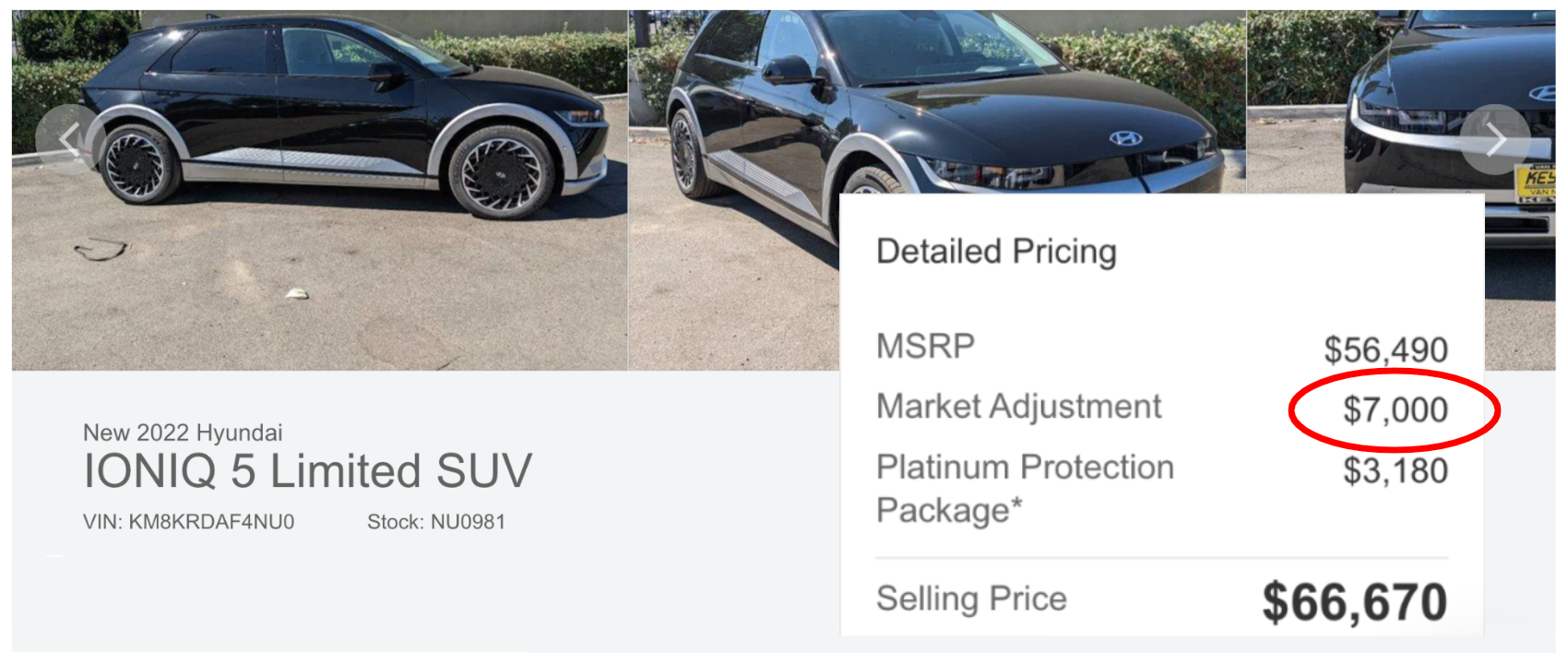Should Dealer Markups Be Illegal? Our Take
Above: Added dealer markup on a 2022 Hyundai IONIQ 5 Limited.
So far this year, the majority of new vehicles purchased from U.S. dealerships have been sold with an added dealer markup, or ADM, above the Manufacturer’s Suggested Retail Price (MSRP).
For consumers, this can be an incredibly frustrating experience, to be shown one price by the auto manufacturer, and another, highly variable price when it comes to actually buying the car. In this trending conversation, the Leasehackr community discusses whether this practice of charging ADMs should be outlawed altogether.
From the perspective of the Leasehackr editorial team, our take is that ADMs are best avoided, but in some cases, they can serve a purpose for buyers and will likely continue to exist so long as manufacturers set the MSRP of a vehicle below its market value.
Rather than fixating on MSRP, we suggest that consumers focus on finding the best available deal given their circumstances—whether it ends up being below MSRP, as has been the case historically, or above MSRP, as may be the case today for popular models.
New Vehicle Supply is Limited, Pushing Up Prices (But Not MSRPs)
As we’ve covered before, the entire global automotive industry has been hit with a semiconductor shortage crisis, hampering the ability of car manufacturers to produce vehicles in volumes they had planned for. The reduction in new vehicle supply has pushed the market price for vehicles up.
The used car market is a good illustration of these rising prices. For the past months, average wholesale auction prices on popular used car models in the U.S. (albeit like-new examples) have frequently exceeded the original MSRP by thousands of dollars.
Yet, despite the increase in prices, nearly all auto manufacturers have been slow to raise MSRPs. (Tesla is the exception, increasing the MSRP on their best-selling Model Y by $13,000 in a year.) Automakers may have numerous strategic reasons for not raising MSRPs (for example, marketing), but the result is that demand at MSRP far exceeds what they can actually supply.
ADMs, at least in theory, function by bringing the price of a vehicle to its market value, serving to better match the demand for a particular car with the supply of available inventory.
A World Without ADM
With all that said, dealers do have an alternative to charging an ADM when a vehicle’s MSRP is below its value in the open market. A small subset of dealers in the U.S. sell their new vehicles at MSRP, for admirable long-term strategic reasons rather than for short-term profit optimization.
The catch, of course, is that demand for a hot vehicle at MSRP exceeds the number of vehicles they have available to sell. Scoring one of those vehicles then becomes a waiting game, requiring persistence, patience, flexibility, connections, and a little bit of luck.
As an example, the biggest Toyota dealership in the U.S., which happens to not charge ADMs, has exactly three new cars in stock at the time of posting—with all three of them being the quirky, $72,000 hydrogen-powered Mirai. To buy any other new vehicle from this dealership, you’ll need to tag an unreserved incoming vehicle, which could range from a short wait (non-hybrid Camry) to being next to impossible to obtain (GR Corolla).
While nobody likes paying ADM, it does provide options for someone who wants to walk into a dealership and purchase a car on the spot.
ADMs Gone Wrong
If it sounds like we’re defending all ADM, that’s certainly not the case.
Far too often, we see egregious examples of dealerships exploiting the information asymmetry between buyer and seller, and adding thousands of dollars in ADM to undeserving vehicles. (We think that anyone who sells a Ford EcoSport above MSRP deserves a special place in Leasehackr hell.)
Added dealer markups do serve a purpose, but unfortunately they can exploited to gouge unsuspecting customers. As always, be sure to shop around and research prices paid by others in the same region as you, before committing to a deal.
Other Ways to Beat ADM
If the uncertainty of being on an incoming vehicle waitlist isn’t your thing, there’s another way to purchase a vehicle without ADM in the current market.
Some dealers allow consumers to custom order vehicles at MSRP, or even at a discount. The reason is that, with certain manufacturers, a customer-ordered vehicle does not come from the same allocation of inventory that a dealer normally gets. An ordered vehicle becomes an extra vehicle for the dealer to sell, essentially getting around the inventory issue.
With this approach, just be sure to have the price agreed upon in writing, and be prepared to wait as the factory builds your vehicle. Note not every manufacturer allows customers to order vehicles through a dealer. In that case, consider expanding your search radius; vehicles popular in one region or state may be unpopular in another. The Leasehackr Marketplace is a good resource for finding dealers and brokers utilized by the Leasehackr community.
By planning ahead and leveraging these techniques, consumers can end up paying significantly below the market price of a vehicle and minimize their vehicle expenses.

